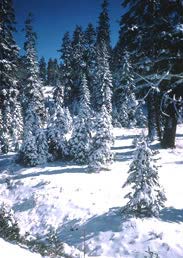And now December’s weather

Will our winter be white? <br>© Photodisc
Meterologists look up for long-range forecasts.
Looking high into the atmosphere now might tell us whether we’re in for a white Christmas. Unusual stratospheric conditions herald changes in winter weather in the Northern Hemisphere up to two months later, say US researchers1.
The finding won’t let your weather forecaster warn you to wrap up warm two months hence, but it may be a valuable addition to meteorologists’ toolkits. “The effect works on average, but it doesn’t happen every time,” says one of its discoverers, Mark Baldwin, of Northwest Research Associates in Bellevue, Washington.
It is currently almost impossible to forecast the weather more than a week in advance. “Everyone’s searching for predictive power on the timescale of 10 days to seasons,” says Brian Hoskins, who studies atmospheric processes at the University of Reading, UK. “It looks as if, for Europe, the stratosphere could provide a bit of that power over a few weeks.”
Baldwin is now working with meteorologists to factor his finding into their computer models of Europe’s climate. “Weather forecasters are aware of the effect, but they’re not yet using it,” he says.
Aim high
The stratosphere begins about 10 kilometres above the ground, and extends to a height of about 50 kilometres. Conditions here generally change more slowly than they do lower in the atmosphere, but there are occasional large shifts in the patterns of air movement.
Baldwin and his colleague Timothy Dunkerton analysed daily satellite maps of a stratospheric air current called the Arctic Vortex. This blows westwards, with occasional reversals, around the top of the globe at 200-300 kilometres per hour.
They found a strong relationship between unusual wintertime conditions in the vortex and subsequent unusual weather in the Northern Hemisphere.
The vortex extends into the lower atmosphere, where it tends to trap cold air at the North Pole. If it weakens, the air can drift south, taking cold, snowy and windy conditions to Europe, Asia and North America. An abnormally strong vortex, in contrast, presages unseasonably mild weather.
Changes that are strong enough to cause weather blips “happen a little more than once a year”, says Baldwin. He also believes that smaller stratospheric changes might affect the weather. The stratosphere could act like a sort of delayed mirror, reflecting changes in the lower atmosphere back down several months later.
The Arctic Vortex is felt through the Arctic and North Atlantic oscillations. These surface air-pressure features strongly influence the Northern Hemisphere’s winter climate. So predictions made using Baldwin and Dunkerton’s model would work best for western Europe.
The correlation between the stratosphere and the lower atmosphere isn’t in doubt, says Tim Palmer of the European Centre for Medium-Range Weather Forecasts, also in Reading. But he is sceptical as to whether there is a physical link between the two layers. Stratospheric air is so thin, he says, that it’s hard to see how it could influence the denser air below.
It is important to answer the question one way or another, says Palmer, as meteorologists need to know whether to include more stratospheric information in their models and observations.
References
- Baldwin, M. P. & Dunkerton, T. J. Stratospheric harbingers of anomalous weather regimes. Science, 294, 581 – 584 , (2001).
Media Contact
All latest news from the category: Earth Sciences
Earth Sciences (also referred to as Geosciences), which deals with basic issues surrounding our planet, plays a vital role in the area of energy and raw materials supply.
Earth Sciences comprises subjects such as geology, geography, geological informatics, paleontology, mineralogy, petrography, crystallography, geophysics, geodesy, glaciology, cartography, photogrammetry, meteorology and seismology, early-warning systems, earthquake research and polar research.
Newest articles
Faster, more energy-efficient way to manufacture an industrially important chemical
Zirconium combined with silicon nitride enhances the conversion of propane — present in natural gas — needed to create in-demand plastic, polypropylene. Polypropylene is a common type of plastic found…

Energy planning in Ghana as a role model for the world
Improving the resilience of energy systems in the Global South. What criteria should we use to better plan for resilient energy systems? How do socio-economic, technical and climate change related…

Artificial blood vessels could improve heart bypass outcomes
Artificial blood vessels could improve heart bypass outcomes. 3D-printed blood vessels, which closely mimic the properties of human veins, could transform the treatment of cardiovascular diseases. Strong, flexible, gel-like tubes…





















